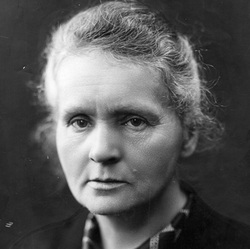|
2/26/2014 0 Comments STEM Women in History! by Nora Dagher Marie Curie A well-known woman in the historical STEM field is Marie Curie, a Polish and naturalized-French physicist and chemist. Curie is famous for her Nobel Prize in Physics (1903), Davy Medal (1903), Matteucci Medal (1904) and the Nobel Prize in Chemistry (1911). Curie's main achievements included a theory of radioactivity, techniques for isolating radioactive isotopes, and the discovery of two elements—polonium and radium (polonium was named after her home country Poland). The Curie Institutes in Paris and Warsaw remain major centers of research and discovery, mirroring the first military field radiological centers established by Curie during WWI. Despite her achievements in the scientific world, Curie died due to aplastic anemia brought on by exposure to radiation, mainly due to the mobile X-ray units created by her. Curie has become an icon in the scientific world and has received international accolades. Poland and France declared 2011 the Year of Marie Curie, with the UN declaring that it would be the International Year of Chemistry. She was the first woman to win a Nobel prize, the first person to win two Nobel Prizes, the woman to win in two fields, and the only person to win in multiple sciences. She has even become a pop culture figure, with her name and face recognizable in all avenues of society. (image link: http://www.biography.com/people/marie-curie-9263538)
0 Comments
2/17/2014 0 Comments Master of Science in PharmacologyThe University of Michigan Chapter of the Scientista Foundation welcomes requests from U-M faculty and staff to post information of interest to U-M Scientistas on our website and C-Tools page. Post requests can be emailed to umichigan@scientistafoundation.com. See below for information regarding the University of Michigan’s Master of Science in Pharmacology. The UMichigan Scientista Lit Team is proud to present you with the February 2014 Newsletter! If you would like to be added to our e-mail list to receive a digital copy directly to your inbox, please fill out the form below. If you would like to contribute to our Newsletter, please e-mail Campus Editor & Publisher Mariam Sheikh at mssheikh@umich.edu. Thank you for your interest in our Newsletters! 2/11/2014 0 Comments Maternal and Childhood Mortality Overview: Dr. Timothy Johnson Lecture for the Global Scholars Program By Nora Dagher Last Friday Jan. 31, the Global Scholars Program hosted a lecture by Dr. Timothy Johnson, an OBGYN focused on global issues surrounding maternal and child health. Johnson's primary field work focuses on maternal and child health in Ghana as well as analyses on women's issues in many third world nations. Johnson outlined that in this day and age of medical advancements, it is unacceptable for maternal mortality rates to be so high. The highest maternal mortality rates are in Afghanistan and the Gaza strip, well known war zones. More than 50% of all deaths occur in countries like India, Nigeria, Pakistan, Afghanistan, Ethiopia, and the Democratic Republic of the Congo. Johnson compared maternal mortality rates at U-M hospital with rates in Ghana. In a single night at a village clinic there were 10 maternal deaths in childbirth, compared to one death from childbirth every 2 to 3 years at UM. In the U.S. if a woman dies in childbirth it is rare and seen as medical malpractice. In Ghana and other war-torn or devastated areas, it is widely known that mothers may not make it back alive from the journey that is childbirth. There is an unspoken culture of acceptance. Frequent issues involving maternal deaths from childbirth are: ectopic pregnancy, abortion, obstructed labor or postpartum hemorrhage. Oftentimes, there is a lack of accessible treatment and poor access to safe cesarean sections, leading to deadly scenarios that are preventable in developed nations. There is a large risk of death by blood loss, and women with HIV in these areas are at a greater risk for infection. In many parts of the world women don't count and there is no one to speak out for them in the political sphere. Ultimately, maternal mortality is a global burden and one that should not be ignored. Maternal mortality is a human rights and social justice issue requiring activism and cognizance from the world community. (image link: http://obgyn.med.umich.edu/contact/news/timothy-johnson) 2/11/2014 0 Comments A Polar Bear at HomeBy Cassi Kirkland Polar bears are considered the largest land carnivores in the world, but they are in trouble. They can be found on most land near Arctic seas including the Alaskan coast, Greenland and Eurasia. Because they depend on sea ice to hunt seals, polar bears are one of the animals most threatened by global climate change. Remy is a polar bear cub at the Toronto Zoo, and he’s seeing snow for the first time. He was born in November, and the only cub of three to survive. Because his health was also declining, Remy has been kept inside for safety reasons. Just last week, Remy was able to see snow for the first time, so enjoy his adorable reaction!  By Cassi Kirkland It seems as though the Earth is plagued with new problems daily. We face global climate change, species extinction, and a host of social issues. Government funding for NASA has considerably decreased; so private non-for-profits are taking matters into their own hands. Inspiration Mars is a nonprofit organization with the goal of sending a two-person American crew to fly within 100 miles around Mars and return to Earth. The target launch date is Jan. 5, 2018, only about four years away. Many see a mission to Mars as entry to a new era of space exploration, and this mission will provide important information to help make a manned mission to Mars a reality. The mission is simple: it uses the gravitational influence of Mars to navigate the astronauts back on course to Earth, and requires no landing maneuvers or entries into the atmosphere. Perhaps more exciting is the idea of a permanent settlement on Mars. This is the goal of Mars One, a not-for-profit organization. They aim to launch crews of four every two years, starting in 2024. Already, hundreds of thousands have applied for this one way ticket to Mars, where they will volunteer to spend the rest of their lives. This is separate from NASA, who has goals for a manned mission to Mars by the 2030s. There are many interesting questions we can ask about such a precarious plan. How will people plan for the high levels of radiation and nonexistent atmosphere on Mars? These people are volunteering to be test subjects on a grand scale, going to a place where almost nothing is known about how the human body will adapt to such drastic changes. We are constantly discovering new health issues from astronauts on the International Space Station, so the transition to full-time life on an entirely new planet is even riskier. Who are these people applying for a one way ticket to Mars? Do they simply love the adventure into the unknown, or are they trying to escape a bad situation on Earth? Better yet, how will the first crew of four be psychologically affected by a two-year stint on Mars? It seems like they would have to create an entirely new government and social system, just to endure the isolation of a year-long mission and a year-long settlement of only four people. (Image Link: http://www.mars-one.com) |
WELCOME, UMICH SCIENTISTAS!
CAMPUS PICS
WHAT'S NEWUPCOMING EVENTSPAST POSTS
October 2022
SORT BY TAG |
The Scientista Foundation, Inc. All Rights Reserved © 2011-2021 | Based in NY | contact@scientistafoundation.org
The Network for Pre-Professional Women in Science and Engineering
The Scientista Foundation is a registered 501(c)(3) -- Donate!
The Network for Pre-Professional Women in Science and Engineering
The Scientista Foundation is a registered 501(c)(3) -- Donate!


 RSS Feed
RSS Feed